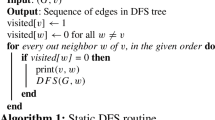Abstract
A linear-time algorithm that does not need a planar embedding is presented for the problem of computing two vertex-disjoint paths, each with prescribed endpoints, in an undirected 3-connected planar graph.
Access this chapter
Tax calculation will be finalised at checkout
Purchases are for personal use only
Preview
Unable to display preview. Download preview PDF.
Similar content being viewed by others
References
Fortune, S., Hopcroft, J., Wyllie, J.: The directed subgraph homeomorphism problem. Theoret. Comput. Sci. 10, 111–121 (1980)
Harary, F.: Graph Theory. Addison-Wesley, Reading, Mass (1969)
Kramer, M.R., van Leeuwen, J.: The complexity of wire-routing and finding minimum area layouts for arbitrary VLSI circuits. In: Preparata, F.P. (ed.) Advances in Computing Research, vol. 2, pp. 129–146. JAI Press, Greenwich, Conn (1984)
Lynch, J.F.: The equivalence of theorem proving and the interconnection problem. ACM SIGDA Newsletter 5, 31–36 (1975)
Perković, L., Reed, B.: An improved algorithm for finding tree decompositions of small width. Internat. J. Foundat. Comput. Sci. 11, 365–371 (2000)
Perl, Y., Shiloach, Y.: Finding two disjoint paths between two pairs of vertices in a graph. J. ACM 25, 1–9 (1978)
Robertson, N., Seymour, P.D.: Graph Minors. XIII. The disjoint paths problem. J. Comb. Theory, Ser. B 63, 65–110 (1995)
Schrijver, A.: Finding k disjoint paths in a directed planar graph. SIAM J. Comput. 23, 780–788 (1994)
Shiloach, Y.: A polynomial solution to the undirected two paths problem. J. ACM 27, 445–456 (1980)
Tholey, T.: Solving the 2-disjoint paths problem in nearly linear time. Theory Comput. Systems 39, 51–78 (2006)
Woeginger, G.: A simple solution to the two paths problem in planar graphs. Inform. Process. Lett. 36, 191–192 (1990)
Author information
Authors and Affiliations
Editor information
Rights and permissions
Copyright information
© 2007 Springer-Verlag Berlin Heidelberg
About this paper
Cite this paper
Hagerup, T. (2007). A Very Practical Algorithm for the Two-Paths Problem in 3-Connected Planar Graphs. In: Brandstädt, A., Kratsch, D., Müller, H. (eds) Graph-Theoretic Concepts in Computer Science. WG 2007. Lecture Notes in Computer Science, vol 4769. Springer, Berlin, Heidelberg. https://doi.org/10.1007/978-3-540-74839-7_14
Download citation
DOI: https://doi.org/10.1007/978-3-540-74839-7_14
Publisher Name: Springer, Berlin, Heidelberg
Print ISBN: 978-3-540-74838-0
Online ISBN: 978-3-540-74839-7
eBook Packages: Computer ScienceComputer Science (R0)




